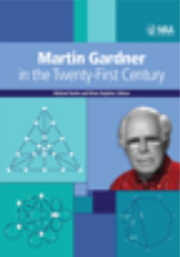Book contents
- Frontmatter
- Preface
- Contents
- I Geometry
- II Number Theory and Graph Theory
- 6 Transcendentals and Early Birds
- 7 Squaring, Cubing, and Cube Rooting
- 8 Carryless Arithmetic Mod 10
- 9 Mad Tea Party Cyclic Partitions
- 10 The Continuing Saga of Snarks
- 11 The Map-Coloring Game
- III Flexagons and Catalan Numbers
- IV Making Things Fit
- V Further Puzzles and Games
- VI Cards and Probability
- VII Other Aspects of Martin Gardner
- Index
- About the Editors
6 - Transcendentals and Early Birds
from II - Number Theory and Graph Theory
- Frontmatter
- Preface
- Contents
- I Geometry
- II Number Theory and Graph Theory
- 6 Transcendentals and Early Birds
- 7 Squaring, Cubing, and Cube Rooting
- 8 Carryless Arithmetic Mod 10
- 9 Mad Tea Party Cyclic Partitions
- 10 The Continuing Saga of Snarks
- 11 The Map-Coloring Game
- III Flexagons and Catalan Numbers
- IV Making Things Fit
- V Further Puzzles and Games
- VI Cards and Probability
- VII Other Aspects of Martin Gardner
- Index
- About the Editors
Summary
It's hard to believe that it was not until 1844 that transcendental numbers were known to exist! But first, a few definitions.
A rational number is one that can written as a/b, where a and b are integers. In decimal form, rational numbers either terminate (1/4 = .25) or they have a pattern of consecutive digits that repeat endlessly (1/7 = .142857 142857 142857 …).
An irrational number is one that cannot be expressed as a/b where a and b are integers. In decimal form, it never ends, and it has no pattern of consecutive digits that keep repeating.
An algebraic number is the root of a polynomial equation with rational coefficients. It can be rational or irrational. Thus 2 is algebraic because it is the root of such equations as 10x = 20. The square root of 2 is algebraic because it is the root of x2 = 2.
Transcendental numbers, such as π and e, are irrational numbers that are not the roots of algebraic equations with rational coefficients.
In 1844, the French mathematical Joseph Liouville (1809-1882) first proved the existence of transcendentals by actually constructing an infinite number of them. Liouville numbers, as they are known, can be called artificial because Liouville did not find them anywhere in mathematics. He simply made them up out of whole cloth.
The simplest Liouville number is the binary transcendental shown below:
.110001000000000000000001 …
The ones are at positions given by consecutive factorials. The first 1 is at position 1! = 1, the second one is at position 2! = 2, the third is at position 3! = 6, the fourth is at position 4! = 24, and so on.
- Type
- Chapter
- Information
- Martin Gardner in the Twenty-First Century , pp. 37 - 38Publisher: Mathematical Association of AmericaPrint publication year: 2012



